Original URL: https://www.theregister.com/2008/01/29/review_maxdata_sbook/
Maxdata Belinea s.book 1 sub-notebook
Hard drive-equipped Eee killer?
Posted in Personal Tech, 29th January 2008 10:02 GMT
First Review Asus' Eee PC has been hogging the limelight thanks to its small size and small price tag. It's also been drawing the attention of competitors, and now there's a stack of would-be Eee beaters coming to market. Maxdata's Belinea s.book 1 is one of the first.
For starters, the s.book comes with Windows XP Pro pre-installed, so out of the box it'll be more familiar to mainstream users than the Linux-running Eee can be. And while it uses the same 7in, 800 x 480 display format as the Eee, the s.book's screen is both touch-sensitive and capable of running at a wider range of resolutions.
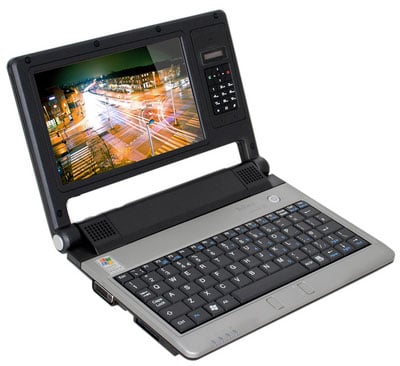
Maxdata's Belinea s.book 1: compact and ultra-portable
And this boy has a hard disk on board: an 80GB unit that offers rather more application, document and media storage than the Eee's meagre 4GB solid-state drive.
The s.book is based on a UMPC reference design, the NanoBook, developed by chip maker VIA last year to highlight its C7-M processor. But Maxdata has tweaked it a bit. The display, mounted to the left side of the laptop's lid, was originally placed alongside a small touchpad, but Maxdata has sensibly moved the navigation device to the slim space in front of the keyboard. In it's place in the screen bezel, there's a pop-out VoIP handset.
The s.book is an attractive unit. The lid's decked out in gloss black, while the rest of the machine is painted satin black. The black keyboard's surrounded by a dark-silver plastic area, home to the touchpad and, above the keyboard, the blue-backlit power button. Beyond this is the screen hinge, home to two stereo speakers, though you'll also find 3.5mm mic and headphone sockets on the laptop's right side.
Maxdata missed a trick by keeping the keyboard – which is the same 21 x 8cm area as the Eee's, with an identical layout – as far forward as it is. There's plenty of room above it, and shifting the keys upward would make room for resting wrists and a larger trackpad. As it is, the 19 x 13mm pad is simply too small, and after a minute or two we plugged in a mouse. The Eee definitely has the edge here.
The Eee has a much nicer screen too. The Eee display is backlit by LED, whereas the s.book has a traditional fluorescent backlight. The difference is immediately obvious when the two are placed side by side. The Eee's screen is crisper and capable of colours of much greater warmth than the s.book's panel.
As we mentioned earlier, the s.book's screen is touch-sensitive – there's a telescopic metal stylus tucked into the lid – but we're not sure that's a big deal. Sure you can tap on icons to open them, but right-clicking isn't straightforward. And who wants to be fiddling with a stylus all the time? Yes you can use your finger instead, but you'll just smear the screen if you do.
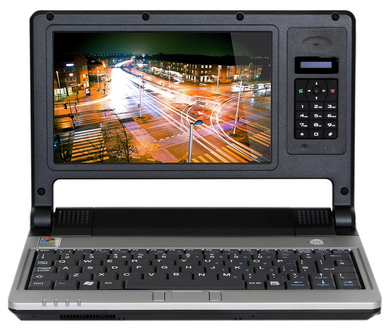
Screen on one side, VoIP handset on the other
We can see why, with the wee trackpad, Maxdata thought it would be clever to implement a touchscreen, but frankly we'd rather just carry on using a mouse. At least there's no Tablet PC nonsense here, and Maxdata's bundled a calibration utility to improve the s.book's ability to work out what your tapping on.
We tried it for a while but continually found our fingers unconsciously and instinctively moving to the trackpad.
The s.book has a pair of USB ports on the right side for this and other add-ons, and a 10/100Mb/s Ethernet port too. On the left side, you'll find a DVI port – a step up from the Eee's VGA connector – and a four-in-one memory card slot that takes SDHC cards, though they poke about 1.5cm out beyond the edge of the machine.
Speaking of connectivity, the s.book has 802.11b/g Wi-Fi too, just like the Eee. But it also has Bluetooth, a technology absent from the Asus. In all, then, this is a well-connected laptop.
But back to the screen. With the pre-installed version of Linux, the Eee is limited to 800 x 480. Under Windows XP, there's an utility from Asus that'll let you flip between 800 x 480 and 800 x 600. The latter retains the screen's native resolution – you just scroll up and down to view the extra vertical pixels.
The s.book likewise starts off at 800 x 480, but its S3 graphics software lets you quickly switch to 800 x 600,1000 x 600 and 1024 x 768, all pinned to the dimensions of the screen so there's no scrolling. Of course, non-native resolutions look pants, but at least it's a quick way of getting more space when you need it. Resolution switching is faster than it is on the Eee, and it's available right out of the box. It's possible to enable this process on the Eee but it's a hacking job, not something for ordinary users.
NanoBook Siblings
Maxdata's Belinea s.book 1 isn't the only sub-notebook based on VIA's NanoBook reference design, nor is it the first. Packard Bell's EasyNote XS20 was announced last autumn, and is available in the UK now. It has the same basic spec as the s.book, but with a 30GB HDD in place of the s.book's 80GB unit and packs a 0.3-megapixel webcam on board. Until recently, PB's UK supplier, the Dixons group, wanted £499 for the XS20, but now it's retailing for around £350.
In the US, Everex has just launched the CloudBook. It too has a 30GB hard drive, but drops Windows XP in favour of the Linux-based gOS. It's aggressively priced at $399 - the same price the 4GB Eee PC commands.
We mentioned that the two machines' keyboards are the same size, but they're not identical. The s.book's is much more spongy, not so much in the key actions but because the whole board seems to have no solid underpinning. That's true of the Eee's keys too, but to a far lesser degree – you have to push very hard to make it dip in the middle and, unlike the s.book, it doesn't dip while you're typing.
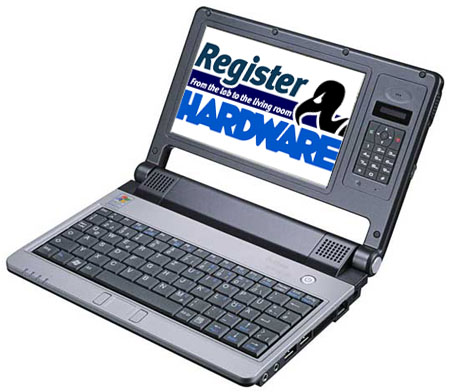
Well-connected
Size-wise, the s.book is only slightly larger than the Eee, though it looks bigger, in part due to the odd screen positioning, but also because it has a chunkier design. The screen hinge is place further back from the keyboard than it is on the Eee, and with the gap between screen and lower section - handy for picking it up, this - it doesn't have the same cramped feel that the Asus does, even though there's barely any difference between the two machines' physical dimensions.
Where the Eee's casing is smooth and sloping, the s.book is all right angles. And it has gaps between its ports, which break up its straight lines and, ironically, make it look not less block-like but more so. The Belinea measures 230 x 171 x 29.4mm.
With the battery in place, it's 1.1kg and feels lighter then the similarly laden Eee, but then the s.book's battery has a capacity of just 2200mAh. At 4200mAh, the Eee's is almost double that. The official s.book runtime is three hours.
The Belinea comes with Windows' Power Options set to the Home/Office Desk power scheme set as default, but we re-set it to Portable/Laptop. We copied an H.264-encoded 640 x 360 video to the s.book's hard drive then set it running full screen and the screen set to maximum brightness to get an indication of battery performance.
Battery Life Results
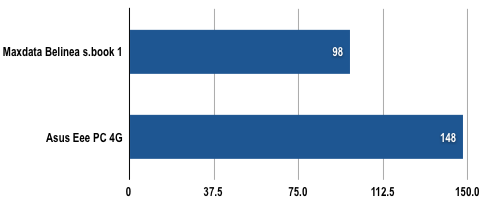
Battery duration in minutes
The s.book went into hibernation after 1 hour 38 minutes, whereas the Eee ran for 2 hours 28 minutes when displaying the same movie at the same settings.
The Eee's battery life is nothing to shout about, but it does run for half as long again as the s.book does. The s.book hard drive activity light barely flashed during playback because the 256MB movie fitted easily into memory, so hard drive operations are likely to knock back the s.book's battery life even further.
Incidentally, video playback was very choppy and effectively unwatchable on the s.book, though the same file played back just fine on the Eee. The Eee has another advantage when it comes to power: a better AC adaptor that's like a phone charger. The s.book's is a standard laptop brick.
The s.book's processor is a 1.2GHz VIA C7-M, backed up with 1GB of 533MHz DDR 2 memory. There's no way to upgrade the memory without taking the laptop to bits. The s.book's CPU certainly has a higher clock speed than the Eee's 900MHz Intel Celeron M, and it makes it presence felt: the system fan that ran constantly throughout use, no matter what we did. You might not notice it on a train, or in a busy location, but in a quiet room it's very obvious.
Even with the fan, the s.book runs remarkably hot for a small machine. So does the Eee, but to a much lesser extent. The Eee has a fan too, and benchmarking the machine quickly got it spinning up, but it was far less intrusive than the s.book's cooler, and in normal use barely spinning at all.
PCMark05 Results
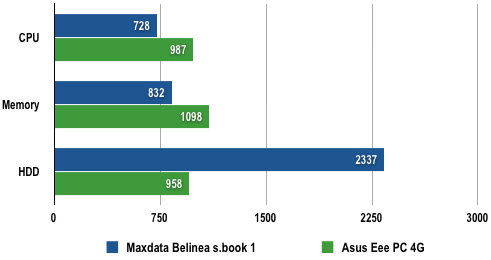
Longer bars are better
We ran PCMark05 on both the Eee and the s.book, focusing on the suite's CPU, memory and HDD tests because neither machine would run the graphics benchmark, thanks to their inferior screen size and unchallenging integrated GPUs.
As you can see from the results above, the Eee's Intel processor scored better than the s.book's VIA chip, despite the two CPUs being rated at 900MHz and 1200MHz, respectively. Clearly, all x86 CPUs are not created equally.
That said, one advantage of the C7-M is its integrated encryption engine which ought to accelerate operations like Virtual Private Network (VPN) communications. We were not set up to test this, but we'd like to hear from anyone who has experience of running VPNs over VIA and Intel machines.
The Eee outshone the s.book in the memory test too, though that's mostly because of the Ram's higher clock speed. Our Eee has 2GB of memory, more than than the standard 512MB, but only double the s.book's complement.
But the s.book's 80GB hard drive really outstripped the Eee's 4GB solid-state drive. Our Eee's 4GB drive is compressed to allow us to squeeze on Windows XP Pro and the all the apps we use, and that may have penalised its score.
Drive, memory and procesor performance shouldn't be taken in isolation, and actually using the s.book, we found it to be entirely fit for purpose. Just as the Eee is. We're big fans of small laptops, and that means we like the Eee at lot. We like the s.book too, but not the pop-out VoIP handset it comes with. It's a small unit about the size of an old iPod Nano. There's a single-line OLED screen, and it connects to the sub-notebook over Bluetooth.
Allegedy, anyway. The unit doesn't even begin to charge until you flip it's tiny on/off switch. When it is, you're left to juggle three apps to get it to work: Toshiba's Bluetooth software; SkyWin, which links the handset to Skype; and Skype itself, which is pre-installed but in a version much later than the one described in the SkyWin manual.
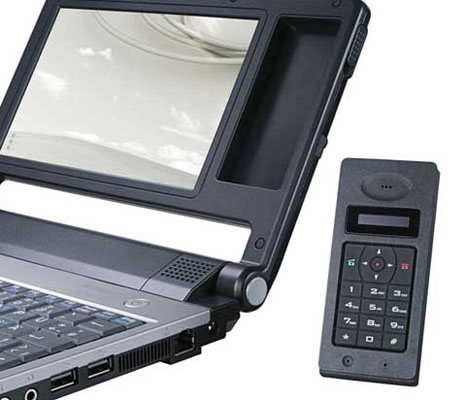
VoIP phone included
After going through this rigmarole, using it proved less than satisfactory. Button presses outlined in the manual didn't appear to work, and some key presses generated 'No API' messages. When we got two computer connected over Skype, we couldn't hear anything through the handset.
If you use Skype frequently and are prepared to put the time in getting the handset set up, good for you. But we suspect most users will get as frustrated with it as we did and, metaphorically speaking, chuck the thing across the room.
Poor add-ons aside, we did enjoy using the s.book. The Eee's relative lack of storage space isn't an issue for us because it's a secondary machine used primarily for writing, emailing and web browsing, but that doesn't mean we can't appreciate having 80GB of hard drive space for songs and other stuff too. Ditto Bluetooth, to be able to connect not to the VoIP gadget but to a mobile phone for cellular connectivity.
The s.book is pleasant to use, easier to type on than the Eee, though the touchpad is too small. This machine doesn't feel as cramped as its rival, even though its screen and keyboard are the same size as the Eee's, and it's only a slightly larger machine. There's no question, it's more comfortable to use than the Asus.
The only real negatives are the battery life, the almost constantly whirring fan and, if you're considering the Eee too, the slower processor. At £420, the s.book's £200 more than the Eee. For us, that's too much to pay for an 80GB hard drive, a rubbish VoIP handset and an unnecessary touchscreen.
Verdict
Like Asus' Eee PC, Maxdata's Belinea s.book 1 is a true UMPC, not one of those ghastly tablet things. It delivers the performance you need for productivity apps and browsing, in a small, easy-to-carry unit that's way cheaper than most small, 'executive' notebooks yet is packed with connectivity options.
Like the Eee, the s.book's short battery limits its mobility, and its constantly whirring fan will annoy some users, but it wins with its big storage capacity, good looks and, frankly, sheer bloody portability. But, at £200 cheaper, Eee remains the better buy.